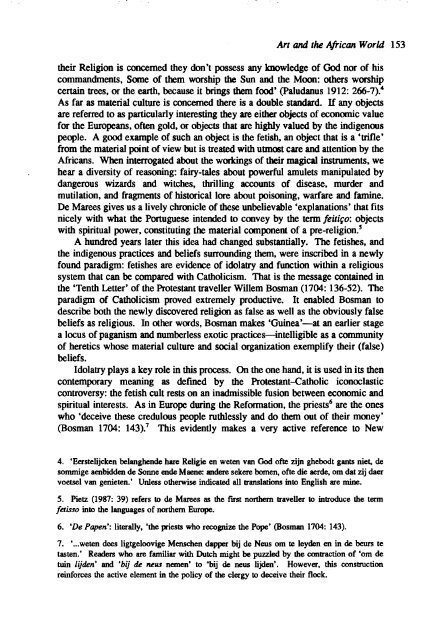1991 No. 1 CONTENTS - Institute of Social and Cultural ...
1991 No. 1 CONTENTS - Institute of Social and Cultural ...
1991 No. 1 CONTENTS - Institute of Social and Cultural ...
You also want an ePaper? Increase the reach of your titles
YUMPU automatically turns print PDFs into web optimized ePapers that Google loves.
Art <strong>and</strong> the African World 153<br />
their Religion is concerned they don't possess any knowledge <strong>of</strong> God nor <strong>of</strong> his<br />
comm<strong>and</strong>ments, Some <strong>of</strong> them worship the Sun <strong>and</strong> the Moon: others worship<br />
certain trees, or the earth, because it brings tbem food' (Paludanus 1912: 266-7).4<br />
As far as material culture is concerned there is a double st<strong>and</strong>ard. If any objects<br />
are referred to as particularly interesting they are either objects <strong>of</strong> economic value<br />
for the Europeans, <strong>of</strong>ten gold, or objects that are highly valued by the indigenous<br />
people. A good example <strong>of</strong> such an object is the fetish, an object that is a 'trifle'<br />
from the material point <strong>of</strong> view but is treated with utmost care <strong>and</strong> attention by the<br />
Africans. When interrogated about the workings <strong>of</strong> their magical instruments, we<br />
hear a diversity <strong>of</strong> reasoning: fairy-tales about powerful amulets manipulated by<br />
dangerous wizards <strong>and</strong> witches, thrilling accounts <strong>of</strong> disease, murder <strong>and</strong><br />
mutilation, <strong>and</strong> fragments <strong>of</strong> historical lore about poisoning, warfare <strong>and</strong> famine.<br />
De Marees gives us a lively chronicle <strong>of</strong> these unbelievable 'explanations' that fits<br />
nicely with what the Portuguese intended to convey by the tenn /eiti,o: objects<br />
with spiritual power, constituting the material component <strong>of</strong> a pre-religion. 5<br />
A hundred years later this idea had changed substantially. The fetishes, <strong>and</strong><br />
the indigenous practices <strong>and</strong> beliefs surrounding them, were inscribed in a newly<br />
found paradigm: fetishes are evidence <strong>of</strong> idolatry <strong>and</strong> function within a religious<br />
system that can be compared with Catholicism. That is the message contained in<br />
the 'Tenth Letter' <strong>of</strong> the Protestant traveller Willem Bosman (1704: 136-52). The<br />
paradigm <strong>of</strong> Catholicism proved extremely productive. It enabled Bosman to<br />
describe both the newly discovered religion as false as well as the obviously false<br />
beliefs as religious. In other words, Bosman makes 'Guinea' -at an earlier stage<br />
a locus <strong>of</strong> paganism <strong>and</strong> numberless exotic practices-intelligible as a community<br />
<strong>of</strong> heretics whose material culture <strong>and</strong> social organization exemplify their (false)<br />
beliefs.<br />
Idolatry plays a key role in this process. On the one h<strong>and</strong>, it is used in its then<br />
contemporary meaning as defmed by the Protestant-Catholic iconoclastic<br />
controversy: the fetish cult rests on an inadmissible fusion between economic <strong>and</strong><br />
spiritual interests. As in Europe during the Refonnation, the priests 6 are the ones<br />
who 'deceive these credulous people ruthlessly <strong>and</strong> do them out <strong>of</strong> their money'<br />
(Bosman 1704: 143).7 This evidently makes a very active reference to New<br />
4. 'Eerstelijcken belanghende hare Religie en weten van God <strong>of</strong>te zijn ghebodt gants niet. de<br />
somrnige aenbidden de Sonne ende Maene: <strong>and</strong>ere sekere bomen, <strong>of</strong>te die aerde, om dat zij daer<br />
voetsel van genieten.' Unless otherwise indicated all translations into English are mine.<br />
5. Pietz (1987: 39) refers to de Marees as the flI'St northern traveller to introduce the term<br />
fetisso into the languages <strong>of</strong> northern Europe.<br />
6. 'De Papen': literally, 'the priests who recognize the Pope' (Dosman 1704: 143).<br />
7. '... weten dees ligtgeloovige Menschen dapper bij de Neus om te leyden en in de beurs te<br />
tasten. ' Readers who are familiar with Dutch might be puzzled by the contraction <strong>of</strong> 'om de<br />
ruin lijden' <strong>and</strong> 'bij de ReUS nemen' to 'bij de neus lijden'. However, this construction<br />
reinforces the active element in the policy <strong>of</strong> the clergy to deceive their flock.
















